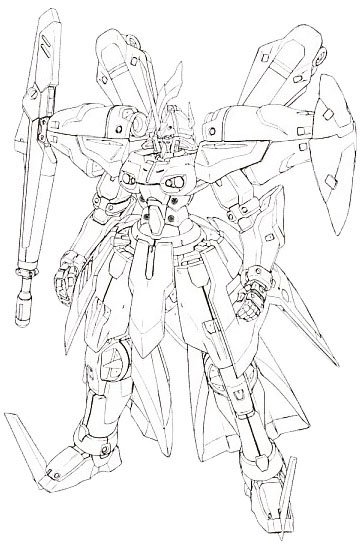|
OZ-15G-2 Idhra Gundam
Model number: OZ-15G-2 Idhra Gundam
The Vanguard Horizon's war against the Earth Sphere Alliance saw that government dealt numerous humiliating defeats against better equipped and trained mobile suit groups. In order to restore their prestige among the other world powers, the Alliance began a broad if somewhat scatterbrained program towards retaliating against the terrorist organization. Included in this effort was the development of numerous new mobile suit prototypes; most would never see the light of day due to overcomplicated designs or other crucial shortfalls. The entire program was scrapped at some point during the Guild War, likely due to the runaway success of mobile doll forces. Decades later, one such prototype, the OZ-15AGX Hydra Gundam, was assigned to disaffected Earth Union pilot Rico Antares as part of the (in)famous 431st Counterinsurgency Battalion. As a highly versatile unit designed to fight the Vanguard Horizon's incredibly varied ranks, the Hydra mounted a broad array of equipment and weaponry to make it as versatile as possible - the mobile suit's large overall size (for an Alliance design) was primarily due to the very powerful reactor that all of the power-hungry systems demanded. The mobile suit was heavily damaged during the African Campaign, and while being reconstructed underwent significant modification. The original 30-year-old specifications were greatly enhanced thanks to the Earth Union's significantly improved technical base as compared to the Alliance's, and while the new mobile suit has no actual GN weapons or systems installed, it has benefitted greatly from advances in construction and fabrication techniques. The Idhra Gundam - name derived from the Greek phoenetic pronunciation of Hydra - reinforces on the original machine's focus on a highly mobility-based combat role, and mounts a dizzying array of weapons and equipment designed to maximize the mobile suit's effectiveness in battle. Offensively, the Idhra has a virtual armory of weapon systems to employ at all ranges - principally, the impressive buster rifle, a beam weapon capable of firing a wide-area burst as well as narrow semi-automatic shots more akin to a standard beam rifle. A pair of strike claws make up the mobile suit's bulky shoulders; these weapons, each of which mounts a variable beam cannon/beam saber, are capable of being deployed and used like a second pair of arms, or the claw portions can detach with a cable guided feature to remotely attack nearby targets. Two relatively standard beam sabers are kept in the mobile suit's forearms for hand-to-hand combat, and a quartet of machine cannons are installed in the abdominal region to make a potent close-quarters defense. The Idhra's head mounts a pair of vulcan guns - typical for Gundam-style mobile suits of the period - but also conceals a very unusual feature in the form of an extremely powerful mega cannon situated in the back of the cranial region. To employ the weapon, the Idhra's head rotates 180 degrees, revealing a secondary "face" with a ZAFT-style mono-eye, of which the mega cannon forms the unit's mouth. The mega cannon produces a very potent diffusing beam attack, which is somewhat limited in range but can obliterate multiple targets at once. The mobile suit's "two-faced" trait led some Union engineers to suggest it might be better called the "Janus Gundam" rather than the code name it officially received. The Hydra's highly effective EMF shield was retained in more or less the same form, and still provides excellent defense in the form of an anti-beam barrier as well as an "arrestor field" that slows the velocity of projectile attacks and missiles, which translates into an overall reduction in destructive potential. Like its predecessor, the Idhra includes a great variety of equipment and features to improve its combat capability. The mobile suit's head is riddled with cameras in the form of conventional camera eyes as well as ZAFT-style mono-eye lenses, providing a high level of sensory perception to the pilot, and likewise its tall antennas offer a good scanning radius. Radar jammers in the Idhra's skirts can be employed to foul enemy sensor coverage, and damaged portions of the Idhra's armor can be physically jettisoned from the body in order to reduce dead weight. Likewise, the Idhra retains the "high mobility mode" of the original Hydra - the addition of close combat weapons in the Gundam's strike claws merely increases this configuration's lethality even more. However, one major adjustment was a final solution towards a single pilot's management of the bewildering arsenal of weapons and combat gear: the PX system. By incorporating an extremely sophisticated computer operating system into the mobile suit's cockpit, the PX is capable of creating much more seamless pilot-machine integration and synchronization, which translates into an improved response time and overall machine handling. The PX also recommends a variety of adjustments to the Idhra's systems and weapon usage, adapting to existing tactical conditions on the fly. While it does create a superior level of battlefield awareness and responsiveness, careful management of the PX system must be maintained, as it can lead to sensory or even mental overloads from the amount of data being processed.
Head detail Rear view Rear view (high mobility mode) |



